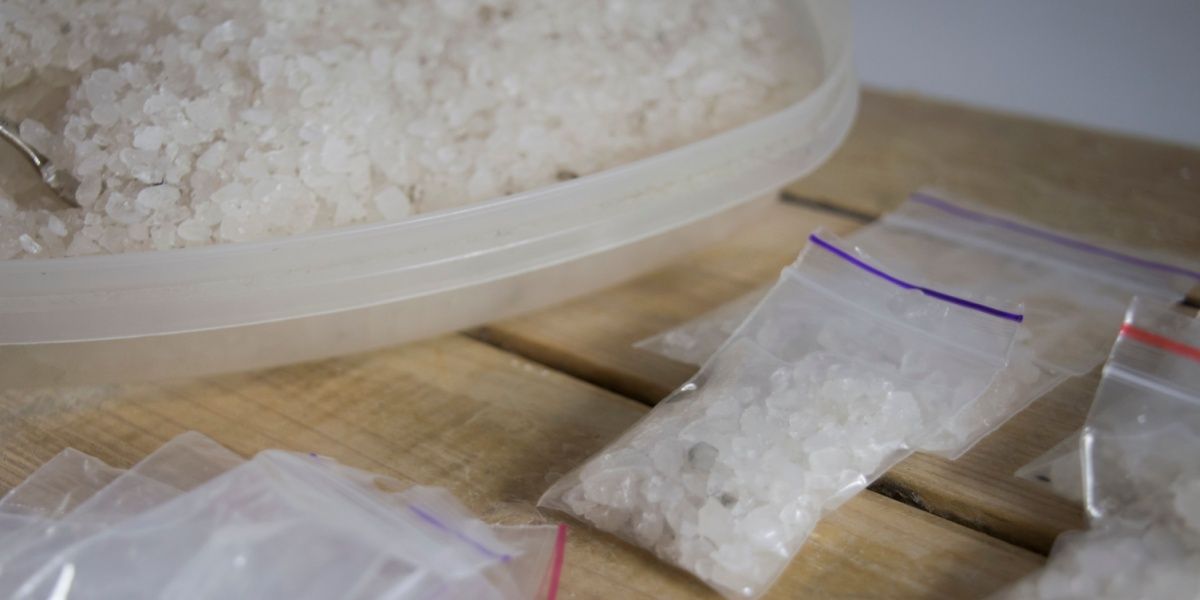Flakka is a synthetic cathinone with effects and a chemical makeup similar to bath salts and CNS stimulants. The adverse side effects of the drug include volatile psychosis, leading it to be dubbed "the zombie drug".
- Flakka, a synthetic cathinone, poses extreme dangers, including volatile psychosis, "excited delirium," and severe physical and mental health complications, earning it the nickname "zombie drug."
- Flakka and bath salts are chemically similar as both belong to the synthetic cathinone class, but they differ in active ingredients, with bath salts typically containing Methylenedioxypyrovalerone (MDPV) and Flakka primarily composed of alpha-Pyrrolidinopentiophenone (alpha-PVP), which lacks the 3,4-methylenedioxy motif found in MDPV.
- Flakka's impact on the brain's dopamine system contributes to its high addiction potential, requiring medical intervention and behavioral therapy for effective treatment.
.jpg?v=1722501748)
What is Flakka?
Flakka is a synthetic, amphetamine-like stimulant that is derived from cathinone found in khat plants.[2] Also known by its chemical name alpha-Pyrrolidinopentiophenone (alpha-PVP) or the street name ‘gravel’, the synthetic drug Flakka is a relatively new designer drug that is believed to have originated in South Florida in the early 2010s and was quickly labeled as a Schedule I substance.
The drug resembles small stones, hence the nickname gravel, and is usually a dusty pink or white color. It is taken either by smoking, injecting, eating, or vaporizing.
Flakka is a DEA controlled drug. Substances in the DEA Schedule I have no currently accepted medical use in the United States, a lack of accepted safety for use under medical supervision, and a high potential for abuse. Flakka is classified by the DEA as a Designer Drug.[1]
Flakka and other synthetic cathinones are known as New Psychoactive Substances (NPS). NPS drugs like synthetic cathinones began to gain prevalence in the early 2000s and were designed to mimic the effects of other drugs such as cocaine, LSD, and ecstasy. Other types of cathinone include Bupropion, Mephedrone, and Methylone.
Effects of Flakka abuse
The initial effects of taking Flakka are similar to those of bath salts and methamphetamines. This includes feelings of euphoria, heightened focus, increased sex drive, and being sociable. When Flakka is abused in high amounts it can cause users to have paranoid, violent, and bizarre behavior, again similar to bath salt abuse.
NIDA, the National Institute on Drug Abuse, has identified Flakka as causing a condition called excited delirium, characterized by hallucinations, paranoia, increased strength, and hyperstimulation. This condition can lead to psychotic episodes that include violence towards others and self-injury. In the mid-2010s, police believe a man who murdered a couple and attempted to eat the male victim's face was high on Flakka. This has led to many referring to the substance as “the zombie drug”.
As well as inducing psychotic episodes, Flakka may also cause hyperthermia, liver and renal failure, hypertension, narrowing of the blood vessels, irregular heartbeat, stroke, heart attack, suicidal ideation, coma, and death. Flakka also has a high potential for overdose, especially when vaporized as the exact amount being taken is hard to quantify. The onset of a Flakka overdose is often rapid and can cause heart problems, aggressive behavior, and psychosis.
Are bath salts and Flakka the same?
The effects of abusing bath salts and Flakka are remarkably similar. Both substances can induce euphoria, heightened sex drive, increased sociability, and hallucinations. When used in excessive amounts, they can lead to severe negative effects, including high blood pressure, elevated heart rate, paranoia, aggression, panic attacks, and psychosis. Both drugs can be consumed in various ways—such as smoking, injecting, or snorting—and carry a significant risk of overdose and death.
On a chemical level, bath salts and Flakka share many similarities; however, they differ primarily in their active ingredients. Bath salts typically contain Methylenedioxypyrovalerone (MDPV), which is characterized by the presence of a specific atom cluster known as the 3,4-methylenedioxy motif. This motif is crucial for the psychoactive effects associated with MDPV.
In contrast, Flakka is primarily composed of alpha-Pyrrolidinopentiophenone (alpha-PVP). Unlike MDPV, alpha-PVP lacks the 3,4-methylenedioxy motif. This difference in chemical structure contributes to variations in their effects and potential for addiction. Alpha-PVP is known for producing intense stimulation and can lead to extreme behavioral changes, including agitation and violent outbursts.
Is Flakka dangerous?
Both Flakka and bath salts are incredibly dangerous when abused, causing harmful side effects, overdose, death, and are addiction-forming. The adverse effects of Flakka abuse, its damaging nature to physical and mental health, and the potential for overdose all make Flakka a highly dangerous drug.
The relatively low cost of Flakka significantly increases its accessibility and appeal, particularly among vulnerable groups such as teens, the homeless, and individuals in low-income areas. While a gram of cocaine will cost around $120-$200, Flakka is far cheaper at approximately $30 to $50 per gram, with individual doses or a "hit" (around 0.1 grams, but dosages may vary) available for $3 to $5. This stark price difference highlights Flakka’s affordability, making it more accessible and amplifying the associated health risks and potential for widespread misuse.
Another danger of Flakka abuse is the long-term nature of the high from it. A hit of cocaine, when snorted, usually lasts around 30 minutes; a hit of Flakka can last for up to five hours. The high from Flakka can also vary depending on the chemical composition. Some Flakka abusers have reported dissociative feelings similar to those felt when abusing benzodiazepines or hallucinogens such as ketamine. Flakka is a dangerous drug but it isn't the only one.
Is Flakka addictive?
Flakka has emerged as a significant substance of abuse, yet research on its addictive properties is still limited due to its relatively recent appearance on the drug scene. Despite this, there is a strong consensus among experts that Flakka has a high potential for abuse, dependence, and addiction. This assessment is based on the drug’s potent effects, its ability to alter brain chemistry, and comparisons with other synthetic drugs like bath salts.
Flakka primarily contains alpha-Pyrrolidinopentiophenone (alpha-PVP), which affects the brain’s reward system by increasing dopamine levels. This alteration can lead to intense feelings of euphoria and energy, but it also creates a cycle of dependency as users seek to replicate these effects. The unpredictable nature of Flakka’s dosage further complicates its use, making it difficult for users to gauge their intake and increasing the risk of overdose. [2]
As with other synthetic cathinones, Flakka’s addictive potential is evident in its ability to produce severe psychological effects such as paranoia, hallucinations, and aggression. These symptoms not only contribute to the compulsive behavior associated with addiction but also lead to significant impairments in cognitive function and emotional regulation over time.
Overall, while more research is needed to fully understand the extent of Flakka’s addictive properties, current evidence suggests that it poses a serious threat to users’ health and well-being.
Treatment for Flakka abuse
Those who have abused Flakka to the extent that psychosis and other aggressive behaviors are present may need to have a course of medication to bring them down to a safe level. These neurological effects may be treated with benzodiazepines to counteract agitation and the physical side effects, mostly relating to cardiac issues, may be treated with low doses of norepinephrine over the course of several hours.[2]
Once a person who has misused Flakka is in a state where they are not a danger to themselves and others, a full diagnosis and course of treatment can be prescribed by a clinician or doctor. This will often be part of inpatient or outpatient treatment programs which include a course of behavioral therapy to help manage addiction, identify causes and triggers of addiction, and treat any co-occurring mental health disorders.
If you or someone you know is suffering from Flakka dependence or addiction, then contact a treatment provider today to discuss what options are available.



-guide-detail.jpg?v=1722501020)
-guide-detail.jpg?v=1722501068)
